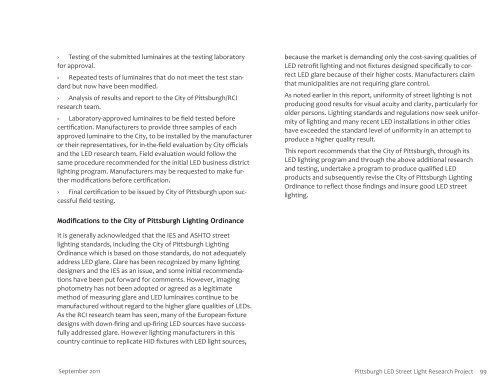LED Street Light Research Project
LED Street Light Research Project
LED Street Light Research Project
You also want an ePaper? Increase the reach of your titles
YUMPU automatically turns print PDFs into web optimized ePapers that Google loves.
› Testing of the submitted luminaires at the testing laboratory<br />
for approval.<br />
› Repeated tests of luminaires that do not meet the test standard<br />
but now have been modified.<br />
› Analysis of results and report to the City of Pittsburgh/RCI<br />
research team.<br />
› Laboratory-approved luminaires to be field tested before<br />
certification. Manufacturers to provide three samples of each<br />
approved luminaire to the City, to be installed by the manufacturer<br />
or their representatives, for in-the-field evaluation by City officials<br />
and the <strong>LED</strong> research team. Field evaluation would follow the<br />
same procedure recommended for the initial <strong>LED</strong> business district<br />
lighting program. Manufacturers may be requested to make further<br />
modifications before certification.<br />
› Final certification to be issued by City of Pittsburgh upon successful<br />
field testing.<br />
Modifications to the City of Pittsburgh <strong>Light</strong>ing Ordinance<br />
It is generally acknowledged that the IES and ASHTO street<br />
lighting standards, including the City of Pittsburgh <strong>Light</strong>ing<br />
Ordinance which is based on those standards, do not adequately<br />
address <strong>LED</strong> glare. Glare has been recognized by many lighting<br />
designers and the IES as an issue, and some initial recommendations<br />
have been put forward for comments. However, imaging<br />
photometry has not been adopted or agreed as a legitimate<br />
method of measuring glare and <strong>LED</strong> luminaires continue to be<br />
manufactured without regard to the higher glare qualities of <strong>LED</strong>s.<br />
As the RCI research team has seen, many of the European fixture<br />
designs with down-firing and up-firing <strong>LED</strong> sources have successfully<br />
addressed glare. However lighting manufacturers in this<br />
country continue to replicate HID fixtures with <strong>LED</strong> light sources,<br />
September 2011<br />
because the market is demanding only the cost-saving qualities of<br />
<strong>LED</strong> retrofit lighting and not fixtures designed specifically to correct<br />
<strong>LED</strong> glare because of their higher costs. Manufacturers claim<br />
that municipalities are not requiring glare control.<br />
As noted earlier in this report, uniformity of street lighting is not<br />
producing good results for visual acuity and clarity, particularly for<br />
older persons. <strong>Light</strong>ing standards and regulations now seek uniformity<br />
of lighting and many recent <strong>LED</strong> installations in other cities<br />
have exceeded the standard level of uniformity in an attempt to<br />
produce a higher quality result.<br />
This report recommends that the City of Pittsburgh, through its<br />
<strong>LED</strong> lighting program and through the above additional research<br />
and testing, undertake a program to produce qualified <strong>LED</strong><br />
products and subsequently revise the City of Pittsburgh <strong>Light</strong>ing<br />
Ordinance to reflect those findings and insure good <strong>LED</strong> street<br />
lighting.<br />
Pittsburgh <strong>LED</strong> <strong>Street</strong> <strong>Light</strong> <strong>Research</strong> <strong>Project</strong> 99


